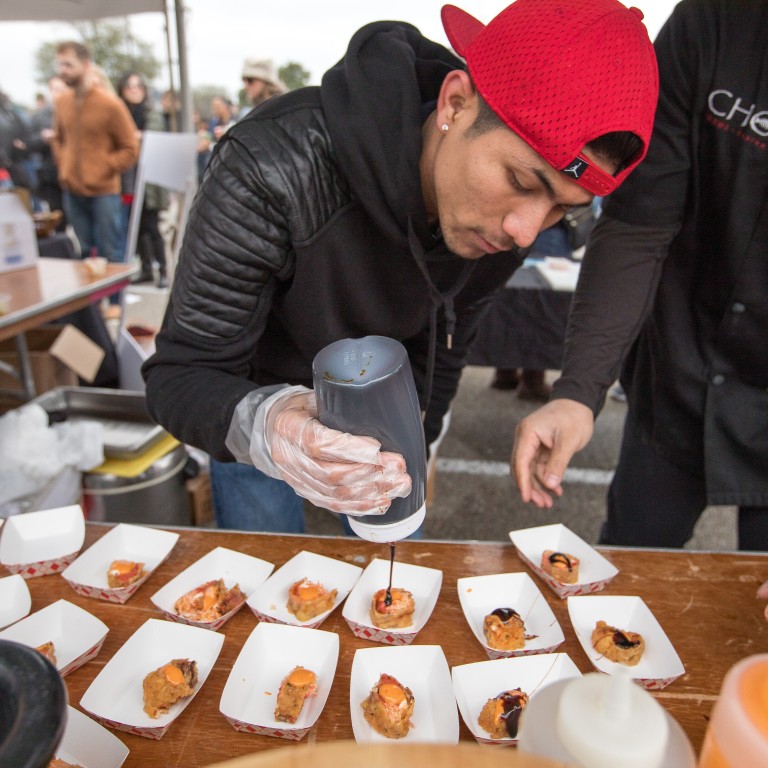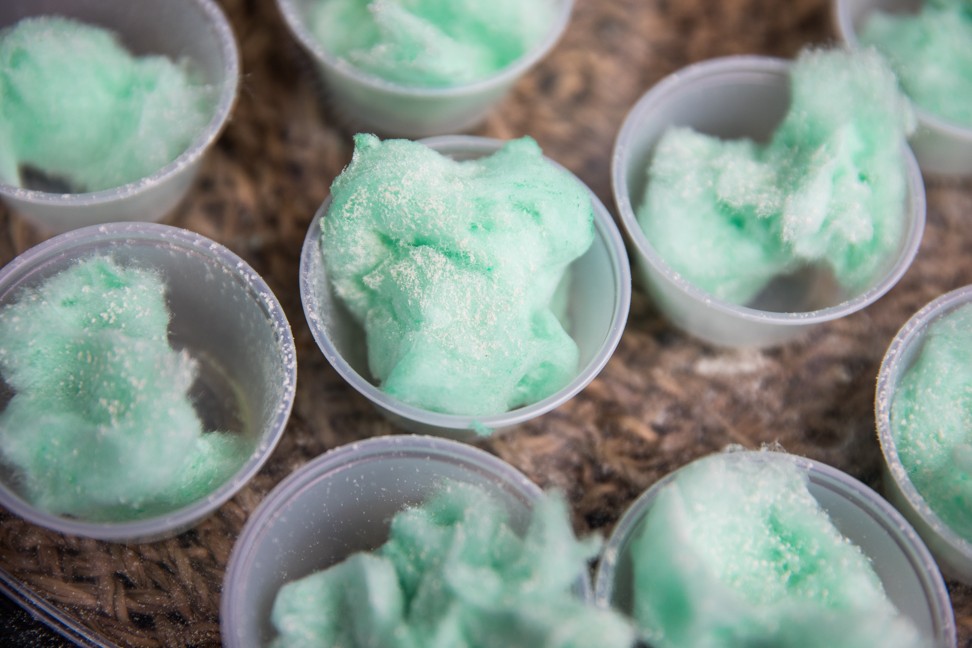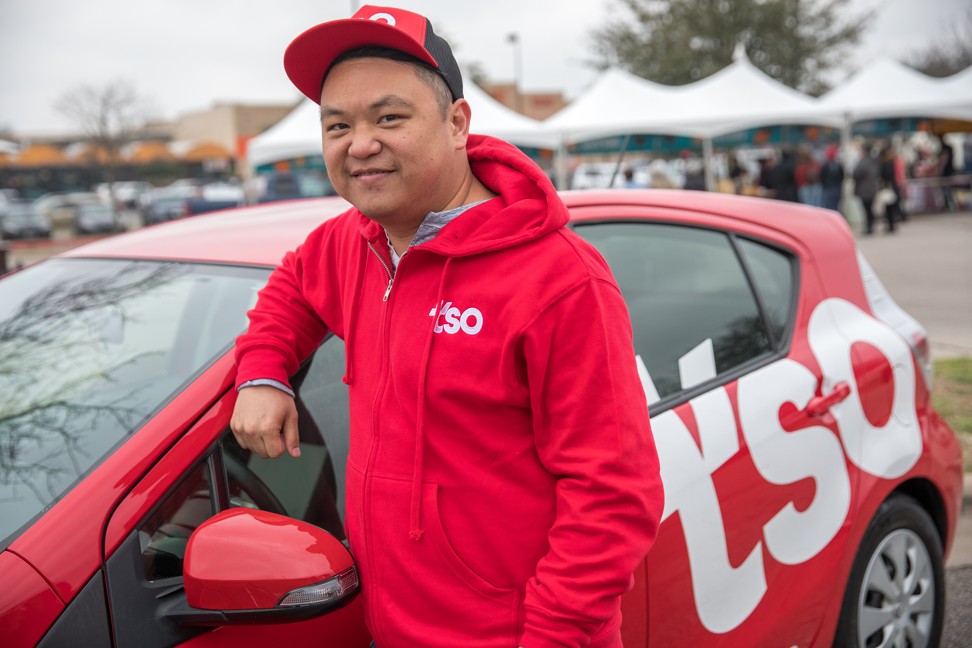
West-meets-East food festival in Austin, Texas celebrates Asian culture and cuisine
- Far East Fest saw 35 Asian-owned restaurants and bars offer a diverse range of delicacies and Asia-inspired cocktails
- The festival is intended to give people exposure to Asian culture and to help local Asians gain a stronger foothold in Austin’s economy
It was a stressful morning for Min Choe and Gavin Booth, who woke up knowing they had something to prove. Their first Far East Fest, a celebration of Asian culture and cuisine, had been a success last year. Now – on one of the coldest days of the year – they had to show the community that the festival could not only last but grow apace with the booming Asian population in Texas.
A stage and a series of marquees had been erected for the February 9 event – one for each of the 35 restaurants and bars taking part – in the expansive car park of a recently opened H Mart, a Korean grocery store chain, in Austin, the state capital.
The day began with everyone huddled together, shivering and talking about the weather. By the afternoon, the car park was mostly full, with lines for mochi, dumplings and ramen stretching the length of the festival ground.
More than 3,000 people, including the mayor, visited the festival that day, eager for a taste of local Asian-American cuisines. The crowds were a testament as much to the blossoming Asian community in Austin as to locals’ openness and hunger for something new.

In the southern United States, and Texas in particular, a rapidly growing Asian population has brought big changes politically and culturally. Between 2000 and 2010 the Asian population in the South grew by 69 per cent, with Texas leading the trend. It is the second most populous state in the US, and Houston is now one of the most ethnically and racially diverse cities in the country.
In 2010, there were already almost one million Asian-Americans in Texas, according to the US Census Bureau. The bureau estimates that number to have risen to 1.37 million in 2017, a staggering 42 per cent jump – making it the fastest growing racial demographic in the state.

While Austin’s Asian population is less well known than Houston’s, the demographic shifts are no less dramatic. Asian-Americans now make up a full 8 per cent of the population and are the fastest growing demographic group, doubling roughly every 12 years, according to the Greater Austin Asian Chamber of Commerce.
Austin’s booming populations of Chinese, Indian, Filipino, Vietnamese, Japanese and Korean people have noticeably changed the cultural fabric of the city. Nowhere is this more clear than in the food.

Choe, a small-business owner and restaurateur, and Booth, a local food media worker, think it’s time to change that.
“The Asian community in Austin is extremely diverse, but there’s a lack of Asian authentic food here. There’s a lot of fusion,” Choe says.
“A lot of people see fusion as a negative; there’s a lot of talk about cultural appropriation and stuff like that,” he adds, shaking his head. “I say we embrace it, and I think Austin is very good at that. That being said, I do love authentic food and I wish we had more of it.”
The story of 99 Ranch Market, largest Asian supermarket chain in US
Choe grew up in Austin but says it wasn’t until university that he realised the value of an event like Far East Fest.
“I realised that there was a lot more cultural segregation, even within the Asian community. So the mission became: how do we bring together the Asian communities?”
To that end, Far East Fest serves as a kind of Texas cookout: a way for neighbours to get to know each other, and for the Asian-American community to share its culture and cuisine.
Booths manned by local Asian-owned restaurants and bars offer visitors samples of the diverse array of Asian delicacies and Asia-inspired cocktails available – all included in the admission price.

What sets it apart from other food festivals, Choe and Booth say, is the support it lends to the vendors and small businesses. The festival is just the public face of a larger outreach programme going on behind the scenes. Participating restaurants are eligible for cash grants and help in marketing and advertising. Far East Fest is not just intended to give non-Asians exposure to Asian culture, but to help the Asian community itself flourish and gain a stronger foothold in the city’s economy.
“We do a lot of work with small-business owners,” Booth says. “There are 30 restaurants here today, and we support a good amount of them through restaurant grants. A lot of them are mom and pop restaurants who don’t have a marketing budget, who might not even know what a marketing budget is. Whether it’s a small-business owner that owns a restaurant or a local community non-profit organisation, we do our best to support them.”
A robust economy and booming technology industry have changed the face of Austin – once a relatively sleepy town – over the past few years. New construction is ever-present. What was once affectionately known as the “velvet rut” thanks to its plush, low-cost, low-stakes quality of life, has become Silicon Gulch, a start-up boomtown where the population is growing by more than 150 people per day.
Five or six years ago, when a lot of people started coming into the Austin area, the food trends changed a lot … Now people know about food that used to only be popular on the east and west coasts
Austin’s brand of openness and entrepreneurial spirit was on display at Far East Fest, which, in tech parlance, could be described as an incubator as much as a food festival.
One of the most popular booths was that of Tso Chinese Delivery, an online-only restaurant co-owned by Choe that he describes as a restaurant start-up.
Angell Tsang is the restaurant’s co-founder and chief technology officer. “I like to say we’re the first Chinese restaurant to ever have its own code base,” he says. “I’ve had a long career in the tech industry in Austin and I knew we wanted to have everything in-house. What’s special about us is that we exist only online: we have delivery drivers, and a website and an all-digital kitchen. We don’t even use paper.”

Tso Chinese Delivery’s marquee at the festival was next to the kitchen of Korea House, Austin’s oldest Asian restaurant, which is still going strong.
When it opened in 1988, knowledge of Korean food was limited, says C.K. Kim, whose parents opened the restaurant.
“We used to serve Korean barbecue and sushi,” says Kim, laughing. “Since then, there have been a lot of changes. Five or six years ago, when a lot of people started coming into the Austin area, the food trends changed a lot … Now people know about food that used to only be popular on the east and west coasts.”
Visitors to the festival were obviously pleased with the food, and enjoyed the dances and cultural performances. But this is America, and the crowd swelled most for the main event: the chow mien eating contest.
An audience as diverse as Texas itself hooted and cheered as a row of hungry diners inhaled enormous quantities of fried noodles – donated by Tso Chinese Delivery – no hands allowed.
In less than 10 minutes there was a surprise winner, the slight, 22-year-old Kentaro Inawa.

After being crowned chow mien champion, Inawa stood in a daze, shivering against the cold, surrounded by friends and adoring fans.
“It was my first eating contest ever,” he said, seeming as surprised by his win as everyone. “The hardest part was braving the cold. The noodles themselves were actually very easy to eat.”
Inawa was born and raised in Austin, one of the next generation of Texans changing the face of their state and the country. As his eyes starting to glaze over from the many portions of noodles, he managed to answer one more question.
“What’s your favourite thing about Austin?”
“The food,” he said. “The food and the people.”

